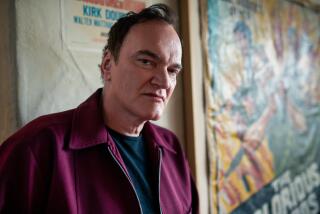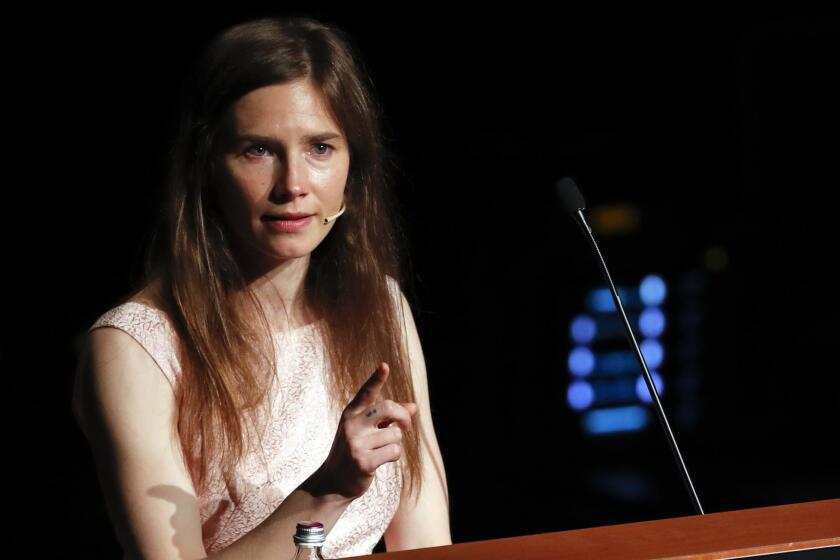21st century Tintin
- Share via
BRUSSELS — He turns 80 this year but still looks 18, with the same fair-haired quiff. Like Madonna and Sting, two other famous blonds, he goes by one name. Mention him and a European is likely to cheer, while an American is more apt to go, “Huh?” But that’s destined to change now that Steven Spielberg is making a movie based on his life.
He is Tintin, intrepid cub reporter and nemesis of evildoers, whose long career in numerous cartoon strips and comic books, with faithful dog Snowy at his side, has made him one of Belgium’s most celebrated exports (up there with chocolate and waffles).
His slightly nondescript but instantly recognizable face is everywhere in Brussels these days, stamped on magnets, posters, key rings and other souvenirs to commemorate the 80th anniversary of his creation. Academics comb the cartoons for clues to Tintin’s ontological meaning and his sexuality. A $20-million museum devoted to his creator is set to open in June outside the Belgian capital.
And amplifying all the buzz -- the Tintin-nabulation, you might say -- is a big-budget 3-D adaptation (using a high-tech motion-capture process) from Spielberg, who bought the movie rights to Tintin’s adventures more than 25 years ago. Joining Spielberg on the project, envisioned as a trilogy of films, is director Peter Jackson of “Lord of the Rings” fame. The first part of filming just wrapped in L.A. (see accompanying story).
In a neat bit of foreshadowing in 1932’s “Tintin in America,” his sole voyage to the States, a victorious Tintin finds himself surrounded by paparazzi and a Hollywood agent who shouts: “Paranoid Productions are starring you in their billion-dollar movie spectacular!” Spielberg’s first Tintin film is budgeted at $130 million.
Not too shabby a fate for an illustrated, French-speaking eternal Boy Scout whose humble origins trace to a conservative Roman Catholic magazine in Belgium between the world wars. “Tintin is a pure Belgian product, with a universal impact,” said Claude Javeau, a professor emeritus at the Free University of Brussels.
The character’s action-packed international romps gave Belgians a window on the wider world from their tiny country, while fans across the globe, especially fellow Europeans, embraced his unassuming, kindhearted and resourceful personality. It also helped that Snowy was adorable.
Tintin sprang from the brain and pen of a young man named Georges Remi, who drew under the name Herge (his initials transposed and pronounced in French). The budding artist worked for the 20th Century, a newspaper run by a right-wing priest who sought to promulgate Catholic values.
At the time, that meant anti-communism, and so Tintin’s debut in “Tintin in the Land of the Soviets” was a breathless thriller set in a Russia full of boorish apparatchiks and “poor idiots who still believe in a ‘Red Paradise.’ ”
Herge would later regret those depictions, as well as less-than-flattering portrayals of Africans and Jews in subsequent tales. But his hero’s first outing was a hit, and Herge went on to rework the formula in 23 more adventures over the next 50 years, in books that have been translated into dozens of languages.
His knickerbockers-clad protagonist gets whisked around the world, from China to Egypt to Australia, and even into outer space to foil the nefarious schemes of crooks, coup plotters and master criminals. Threats and bribes do not deter him; neither do a pair of bumbling, bushy-mustached cops called Thomson and Thompson.
In every adventure, Tintin lands in hot water -- “This time I’m done for!” is a frequent refrain -- but a combination of quick thinking, luck and help from Snowy enables him to outfox his enemies. He manages to evade even his editors, for, despite being a reporter, he is only ever once shown writing anything.
Children devour the exciting plots and the hair-raising escapes aboard planes, trains and automobiles (speedboats too). Their parents are charmed by the good humor and the artwork, which, though seemingly simple, is a model of lucidity and detail. Herge’s mastery of the so-called ligne claire style, or “clear line,” influenced numerous European cartoonists after him.
“When I was a young child, I read ‘Tintin’ and loved it. When I was older, I continued to read it. And now I am much older, and I continue to enjoy them,” said Benoit Peeters, a Belgian cartoonist who knew Herge well. “This is very rare. You have some comics for children, others for adults. This is for everyone. You can say ‘Peanuts’ by Charles Schulz has the same quality. Not many have.”
Like “Peanuts,” the Tintin books are unremittingly wholesome. Modest to a fault, Tintin himself is almost never less than a paragon of old-fashioned virtue, which is unsurprising, given that Herge modeled him on a previous creation named Totor, a Boy Scout leader. “Tintin is above reproach. He is trying to save the widows and orphans,” Javeau said.
Herge’s own strong moralizing impulse meant that his stories contained hardly a hint of sex or alcohol -- except, in the latter case, as a comically corrupting influence. Toward the end of his life, Herge eliminated depictions of smoking from his cartoons as well, Javeau said.
But there was a darker side to the conservative rectitude. During World War II, Herge agreed to publish his Tintin strips in the newspaper Le Soir, or the Evening, a mouthpiece for Nazi occupying forces that spewed pernicious anti-Jewish propaganda. His defenders contend that Herge was simply being politically naive, but a recent authorized biography suggests that, though not a Nazi, Herge was not unaware of what Le Soir stood for.
Traces of anti-Semitic stereotypes crop up in some Tintin books but were excised from later editions. Even more distasteful, at least to modern eyes, is Tintin’s adventure in what was then the Belgian Congo, in which the Africans are rendered with ludicrously large red lips and portrayed as little more than savages in need of civilization and a proper work ethic.
Americans did not fare too well under Herge’s hand either, which could help explain why Tintin never caught on in the U.S. In “Tintin in America,” he jousts with “Red Indians,” rapacious oil barons and a gaggle of Chicago mobsters, including Al Capone, the only real-life villain ever to be featured in a Tintin story.
American comics fans were already following the exploits of Dick Tracy and Superman by the time the indefatigable, squeaky-clean Tintin was making it big across the Atlantic.
“America has its own traditions, very rich, through comic strips or comic books with superheroes,” Peeters said. “ ‘Tintin’ is in a way a graphic novel, but the style of the books was very far from American standards. . . . The graphic style is different. There is no equivalent. You can find some people in the United States interested in that type of comics, but not a large audience.”
Tintin’s relative obscurity in the U.S. and his huge reputation in Europe will pose a double challenge to Spielberg and his “Adventures of Tintin: Secret of the Unicorn,” which stars two British actors, Jamie Bell and Daniel Craig, as Tintin and the villain, respectively.
Many American viewers will be encountering Tintin for the first time, while many Europeans are extremely protective of a hero they consider their own and suspicious of how an American filmmaker might tamper with the image of him they have built up.
A taste of that defensiveness came in January after a well-known British columnist, who is gay, suggested that Tintin might be similarly inclined. After all, the world depicted in the books is almost exclusively male, Tintin is devoted to his fluffy white terrier, and he eventually moves in with his friend, the middle-aged sailor Captain Haddock.
“What debate can there be when the evidence is so overwhelmingly one-way?” columnist Matthew Parris asked in the Times of London.
That Tintin might be gay is not a new idea, though the books themselves determinedly steer clear of sex or romance of any sort. “Perhaps there was a horizontal relationship between Tintin and Captain Haddock, but you never see it,” Javeau said.
Still, Parris’ column was met with cries of Gallic horror in France, where the newspaper Le Figaro complained in a headline: “They have walked on Tintin.”
Although some alterations to the original Tintin will probably be inevitable in the film, Herge himself apparently approved of a Spielberg-produced movie version of his famous creation. Whatever ambivalent attitudes seem to mark “Tintin in America,” the artist dreamed of success in the U.S. and once contacted Walt Disney about working together, to no avail, Peeters said.
Spielberg bought the movie rights not long before Herge’s death in 1983.
“Herge was very enthusiastic. He liked the first films of Spielberg,” Peeters recalled. “Herge said, ‘Yes, I think this guy can make this film. Of course, it will not be my Tintin, but it can be a great Tintin.’ And I think it was one of the last happy moments in Herge’s life.”
--
More to Read
The biggest entertainment stories
Get our big stories about Hollywood, film, television, music, arts, culture and more right in your inbox as soon as they publish.
You may occasionally receive promotional content from the Los Angeles Times.











